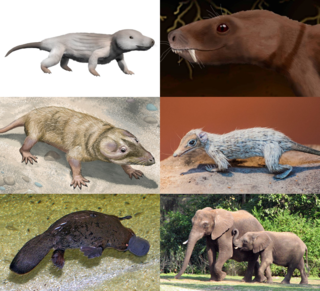
Cynodontia is a clade of eutheriodont therapsids that first appeared in the Late Permian, and extensively diversified after the Permian–Triassic extinction event. Mammals are cynodonts, as are their extinct ancestors and close relatives (Mammaliaformes), having evolved from advanced probainognathian cynodonts during the Late Triassic.
Lepagia is an extinct genus of poorly known carnivorous cynodonts, which lived during the Upper Triassic in Europe. Partly due to the paucity of remains the precise affinities of this genus are unclear. It seems reasonably closely related to Probainognathus, a somewhat earlier inhabitant of South America. The genus Lepagia was named by Hahn, Wild and Wouters in 1987 based on a single species.
"Hahnia" obliqua is a poorly known species of meat-eating stem-mammals (cynodonts) that lived during the Upper Triassic in Europe. It is based on tiny, isolated teeth, and its affinities with other cynodonts are unclear. The generic name is not valid, thus the quotation marks. The name Hahnia has already been used for a spider. The authors are aware of this, and will doubtless come up with a new name sometime in the future.
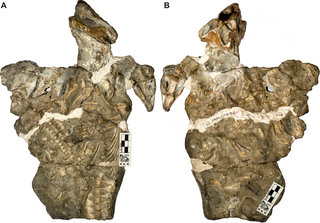
Galesaurus is an extinct genus of carnivorous cynodont therapsid that lived between the Induan and the Olenekian stages of the Early Triassic in what is now South Africa. It was incorrectly classified as a dinosaur by Sir Richard Owen in 1859.

Therocephalia is an extinct clade of eutheriodont therapsids from the Permian and Triassic periods. The therocephalians ("beast-heads") are named after their large skulls, which, along with the structure of their teeth, suggest that they were carnivores. Like other non-mammalian synapsids, therocephalians were once described as "mammal-like reptiles". Therocephalia is the group most closely related to the cynodonts, which gave rise to the mammals, and this relationship takes evidence in a variety of skeletal features. Indeed, it had been proposed that cynodonts may have evolved from therocephalians and so that therocephalians as recognised are paraphyletic in relation to cynodonts.
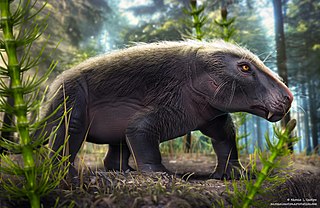
Traversodontidae is an extinct family of herbivorous cynodonts. Traversodonts were primarily Gondwanan, with many species known from Africa and South America. Recently, traversodonts have also been found from Europe and North America. Traversodonts first appeared in the Middle Triassic and diversified in the Late Triassic before going extinct at the end of the epoch. The family Traversodontidae was erected by Friedrich von Huene in 1936 for cynodonts first found in São Pedro do Sul in Paleorrota, Brazil.
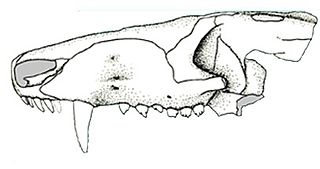
Prozostrodon is an extinct genus of probainognathian cynodonts that was closely related to mammals. The remains were found in Brazil and are dated to the Carnian age of the Late Triassic. The holotype has an estimated skull length of 6.7 centimetres (2.6 in), indicating that the whole animal may have been the size of a cat. The teeth were typical of advanced cynodonts, and the animal was probably a carnivore hunting reptiles and other small prey.

Progalesaurus is an extinct genus of galesaurid cynodont from the early Triassic. Progalesaurus is known from a single fossil of the species Progalesaurus lootsbergensis, found in the Lystrosaurus Assemblage Zone of the Balfour Formation. Close relatives of Progalesaurus, other galesaurids, include Galesaurus and Cynosaurus. Galesaurids appeared just before the Permian-Triassic extinction event, and disappeared from the fossil record in the Middle-Triassic.
Menadon is an extinct genus of traversodontid cynodonts. The type and only species is Menadon besairiei.
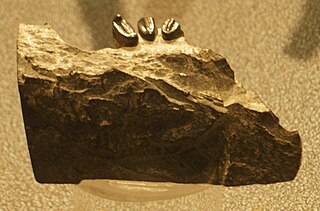
Gornogomphodon is an extinct genus of cynodonts from the Gorno Formation of Bergamo, Italy. It existed during the Middle Carnian age of the Late Triassic. It contains only one species: Gornogomphodon caffi.
Arctotraversodon is an extinct genus of traversodontid cynodonts from the Late Triassic of Canada. Fossils first described from the Wolfville Formation in Nova Scotia in 1984 represented the first known traversodontid from North America. The type and only species is A. plemmyridon and is represented by teeth and several dentary bones.
Plinthogomphodon is an extinct genus of traversodontid cynodonts from the Late Triassic of the eastern United States. Fossils have been found from the Deep River basin of North Carolina, part of the larger Newark Supergroup. It is known from a single eroded snout. The type and only species is P. herpetairus.
Maubeugia is an extinct genus of traversodontid cynodonts from the Late Triassic of France. Isolated postcanine teeth are known from Saint-Nicolas-de-Port in northeastern France. The type species M. lotharingica was named in 1997. Many other cynodont teeth were found alongside those of Maubeugia, including those of dromatheriids, probainognathids, and other traversodontids. The size of its teeth indicates that Maubeugia was a dwarf traversodontid. The deposit in which the teeth were found indicates that it lived along the shoreline of an ocean.
Rosieria is an extinct genus of dwarf cynodonts from the Late Triassic of France. It belongs to the family Traversodontidae, a herbivorous group known mainly from Gondwana. The type species R. delsatei was named in 1997 on the basis of a few isolated postcanine teeth found in Saint-Nicolas-de-Port in northeastern France. These teeth were found alongside the teeth of many other cynodonts, including those of Hahnia, Gaumia, and Maubeugia. The small size of the teeth in Saint-Nicolas-de-Port suggest R. delsatei and other species were dwarf cynodonts. Most teeth in the locality belong to insectivores like dromatheriids, while those of R. delsatei and other herbivorous cynodonts are very rare.
Scalenodon is an extinct genus of traversodontid cynodonts from the Middle Triassic of Africa and possibly Russia. The type species S. angustifrons was named in 1946 and several other species were named in the following years. Most of the species from Africa are now thought to belong to different genera than Scalenodon.

Cricodon is an extinct genus of trirachodontid cynodonts that lived during the Early Triassic and Middle Triassic periods of Africa. A. W. Crompton named Cricodon based on the ring-like arrangement of the cuspules on the crown of a typical postcanine tooth. The epithet of the type species, C. metabolus, indicates the change in structure of certain postcanines resulting from replacement.

Etjoia is an extinct genus of traversodontid cynodonts that lived during the Middle Triassic or Late Triassic period in southern Africa. This medium-sized omnivorous cynognathian provides important information on the dental evolution of early diverging gomphodonts and traversodontids.
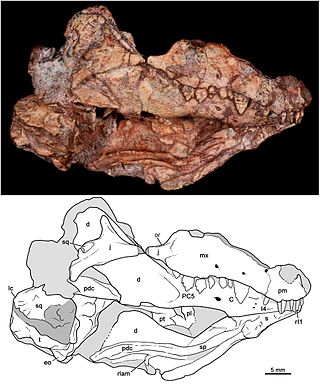
Bonacynodon is an extinct genus of cynodonts that lived in what is now southern Brazil during the Triassic period. The genus is monotypic, containing only the type species Bonacynodon schultzi. B. schultzi is known from two specimens, consisting of two partial skulls and some badly preserved parts of the postcranium. Both specimens were recovered from the Pinheiros-Chiniquá Sequence, part of the Santa Maria Supersequence of the Paraná Basin. This sequence preserves a faunal association known as the Dinodontosaurus Assemblage Zone, which contains numerous other species of cynodonts, dicynodonts and reptiles. Bonacynodon was a small, likely insectivorous cynodont, whose length has been estimated at around 30 centimetres (12 in). It can be distinguished from other cynodonts by its large, serrated (saw-like) canine teeth. Together with the genus Probainognathus of Argentina, it made up the family Probainognathidae, one of the earliest-diverging lineages of the clade Probainognathia. It was a fairly close relative of mammals, the only group of cynodonts alive today.
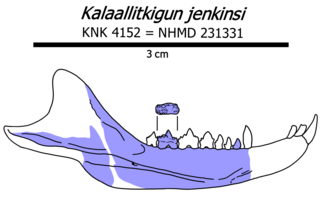
Kalaallitkigun is an extinct genus of haramiyidan mammaliaforms from the Late Triassic of Greenland. It contains a single species, Kalaallitkigun jenkinsi, which was described in 2020 from a partial dentary found in the Fleming Fjord Formation. More specifically, it was found in the mid-late Norian Carlsberg Fjord beds of the Ørsted Dal Member. It is the oldest of several mammaliaform species discovered in the Late Triassic sediments of Greenland. It is also the oldest mammaliaform with double-rooted teeth, and its pattern of tooth cusps help to clarify the evolution of haramiyidan teeth relative to their morganucodont-like ancestors.
Inditherium is an extinct genus of dromatheriid cynodonts that lived in what is now India during the Late Triassic. Its type and only species is Inditherium floris, which is known from three postcanine teeth discovered at the Tiki Formation of Madhya Pradesh.
















